Interpreting the work of an Antwerp fashion designer and his eponymous label in five looks
😃 Today’s surprise post is part of April Cools’ Club, where participating creators surprise their readers with something very different from their usual subject matter. Enjoy this one-off celebrating the work of one of my favourite fashion designers. This time, this really is my last newsletter (for now, for real!)
🍃 New event announcement! I will be speaking at Content Rising, a one-day conference for environmental creatives and content producers. The conference takes place at Kew’s Wakehurst in Sussex on Thursday 12 June. My talk is called Human Decentred Design — and will be an extended, updated version of what I presented at The Conference, last year in Malmö. Keep an eye on Wilsome — the event’s organiser — as more details are announced: BlueSky // Instagram // LinkedIn 🍃
👾 Another super-mega-advance announcement! I will also be speaking at Web Dev Conf in Bristol on Friday 10 October. WDC started in 2007 and they work to create an inclusive space for anyone working with the web at all levels. I will be speaking on Death, and how tech forgot about mortality. Early-bird tickets are available now! 🕹️
📚 As always, you can buy books mentioned in this newsletter from my page on Bookshop.org
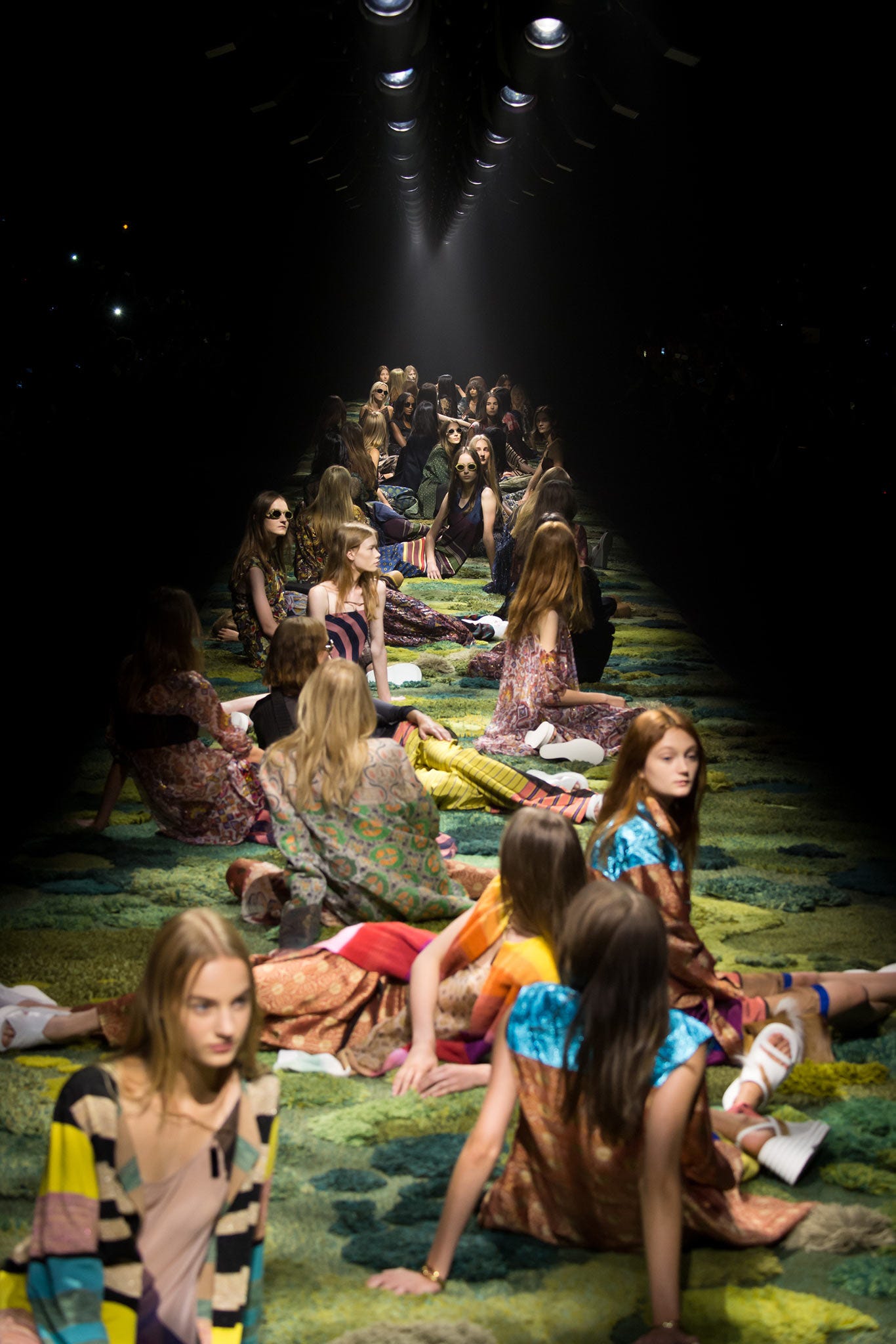
Dries van Noten is the founder of his eponymous label, which was established in 1986. A graduate of the Royal Academy of Fine Arts in Antwerp, Dries van Noten has developed a signature aesthetic that incorporates intricate embroidery, vibrant silks, and geometric prints influenced by Japanese and Indian techniques.
Despite changing tastes over the last four decades, Dries van Noten has always promoted vibrant colour for men.
Today’s newsletter showcases what his work means to me — told in five looks.
Tailoring
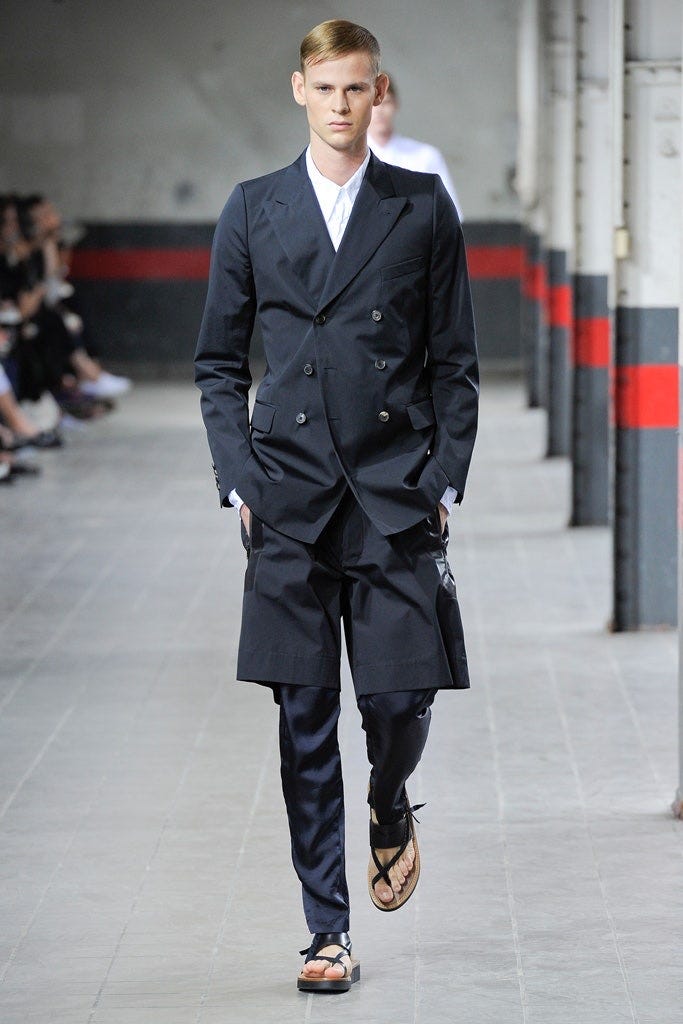
Tailoring is central to every Dries van Noten collection. Absorbing influences from his parents’ and grandparents’ previous tailoring businesses — regardless of the story being told on the catwalk or the themes being explored in dress — the formal suit and white shirt are both ubiquitous.
In “Garage”, the menswear Spring 2012 collection, there was an interplay of traditional tailoring fabrics — worsted and cotton — but as the show went on, vibrant stripes popped and electric nylons vied for attention. The mish-mash of tailoring and performance fabrics creates a visually and texturally contradictory look.
Look 5 (pictured above) is a favourite of mine. Navy and white is a menswear staple. However, the reason this look is memorable is due to the interplay of proportions that gesture to a mastery of the bella figura that many tailors aspire to, but all too often miss. A firm shoulder with a roped arm seam is the basis for a classically tailored jacket; however, it is the wide-legged navy shorts over the slim-legged trousers that draw attention to the way these layers work with each other in motion.

Movement in tailoring is equally dependent on the cut, and the movement afforded by the weight, directional bias, and weave of the cloth.
Dries van Noten continually returns to renowned mills across England, Scotland, Italy and beyond. In a moment of levity during show #99 “Mod” — a collection that reimagines the evolving sartorial stand-off between formal dress and youth culture — the provenance of the fabrics are blown out of proportion. Oversized labels, such as Fox Brothers, dominate. Brand is amplified into being the garment — a self-referential parody of fashion’s logo obsession dominating the way we dress today.
Graphics
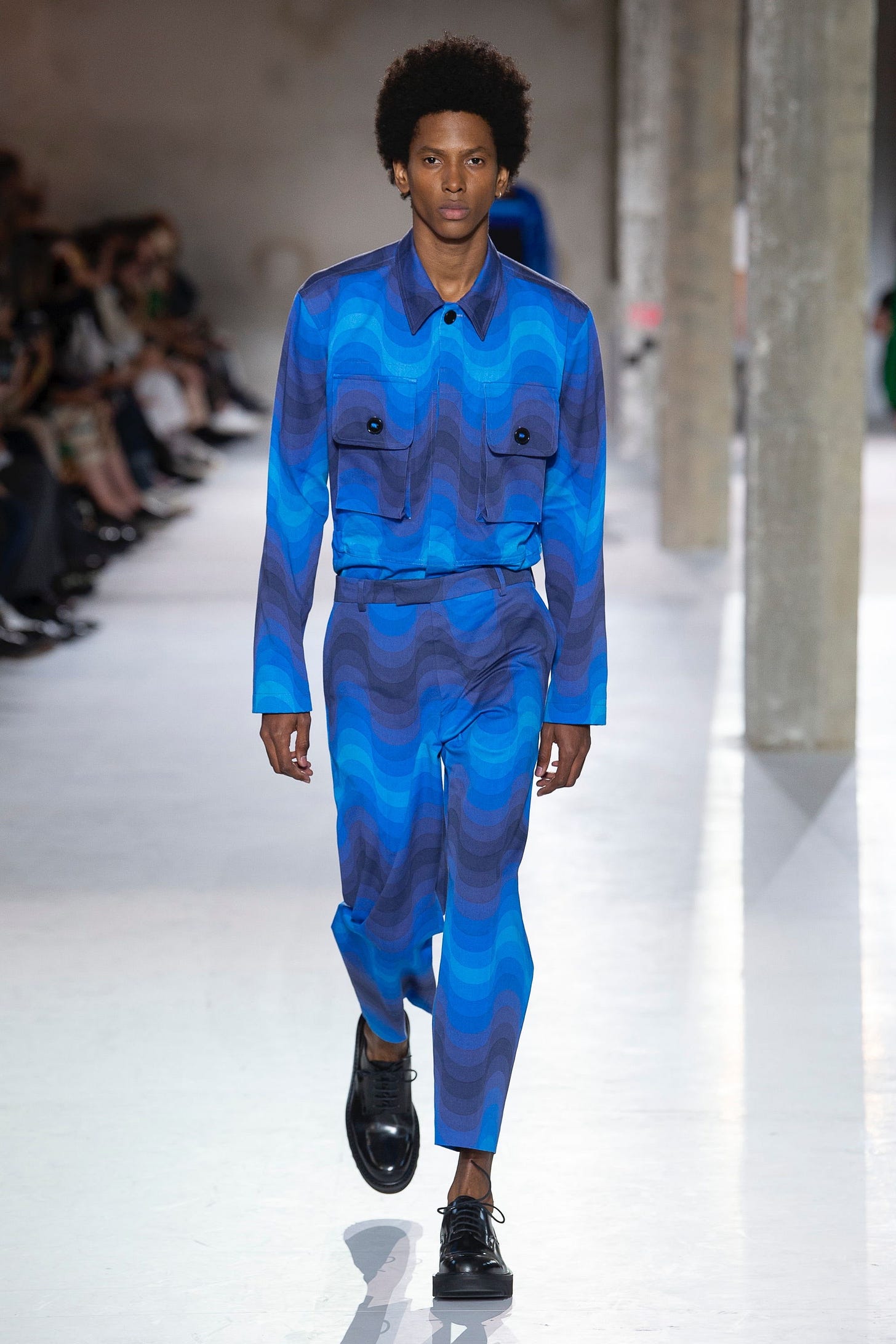
Each season, I am often most interested in the story told through the collection’s influences — for Dries van Noten, these reference points span the wider art and design scenes.
For his 105th show, Dries van Noten announced a menswear collection that paid tribute to the Danish interior designer Verner Panton, who died in 1998.
What elevates a designer’s ambition to me is an ability to observe the work of someone working in a seemingly unrelated field, before being able to draw parallels in their mastery of their craft — or, to put it more prosaically: how a designer can look at the colour, soft furnishings and furniture in a room before being inspired to create a series of suits, coats, resort wear pieces and present them in a choreographed sequence that tells a pulsating colour story.
Embroidery
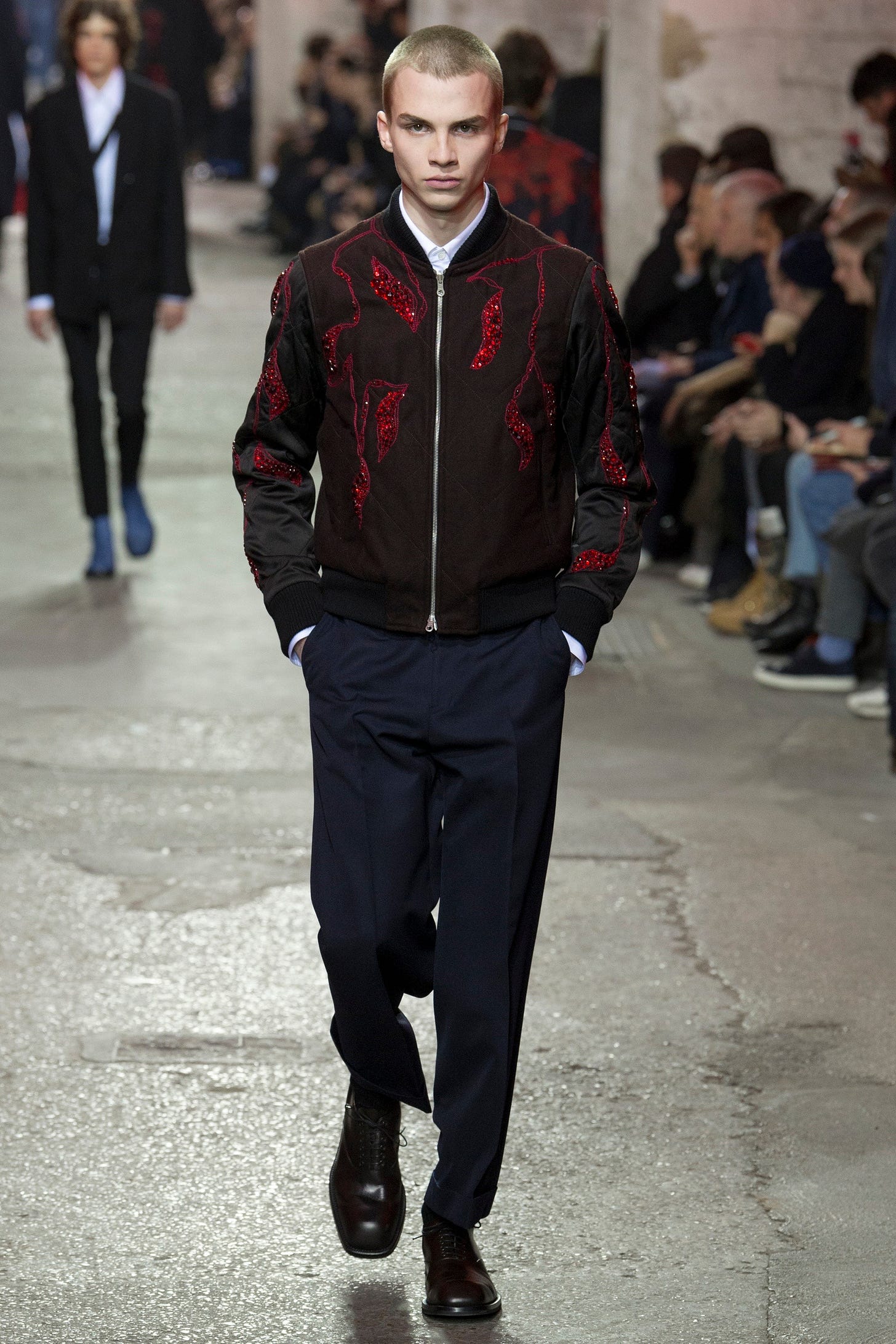
Each season, there are usually pieces in a Dries van Noten collection — menswear and womenswear alike — that feature intricate hand-made embroidered details.
To see any of these pieces up close is a privilege. You can feel the weight and intricacy of each design. On closer examination, you get a sense of the time taken to place each thread or sequin.
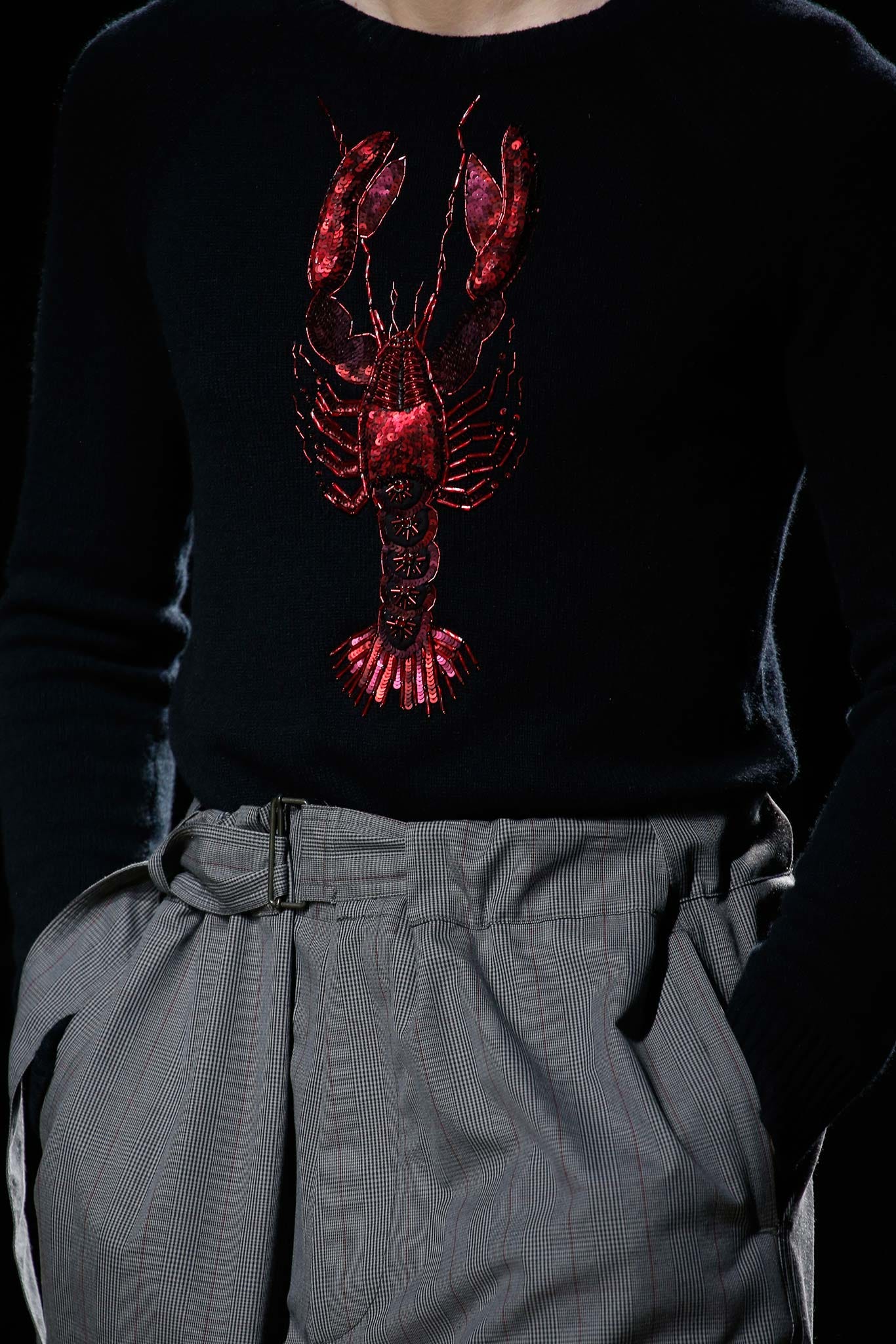
The motifs used are often a nod to the broader theme of the catwalk collection. Dries van Noten works closely with an artisanal embroidery workshop in India and makes a point of including pieces in each collection that feature their handiwork.
In this detail from “Marilyn” — the Spring 2016 menswear show — the image of the actress features in oversized, black and white on red, and all-over prints. But surrealist influences are evident. This opulent lobster makes an appearance constructing the visual effect of being suspended midair as it floats mid-chest of this black sweater.
Florals
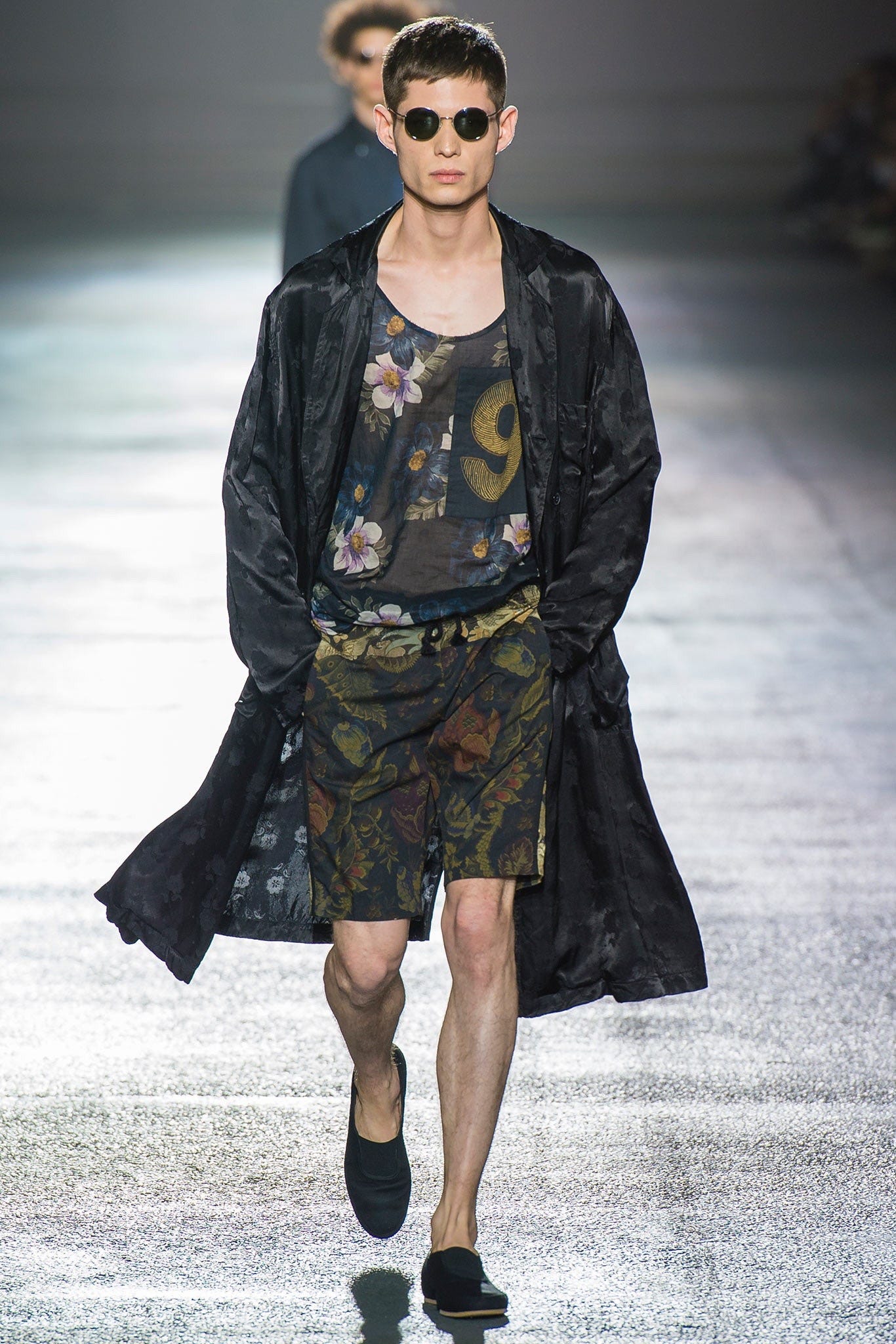
Your nose will tell you the first time you enter. Step into a Dries van Noten store, and you will be greeted by a mixture of floral aromas. Floral arrangements are changed frequently. Vibrant petals and sculptural vases are near the entrance, by the tills — and, if you are in the Antwerp flagship at Het Modepalais — at the top of the staircase.
Floral motifs, prints, and petals feature regularly in Dries van Noten’s work. However, for the Spring 2014 menswear collection “Flowers for Men”, flowers were central to this collection.
Coinciding with “Inspirations”, exhibitions shown at the Museé des Art Decoratifs in Paris and MoMu in Antwerp between 2014-2015, Dries van Noten’s research for this collection examined European men and their historic relationship with flowers. Archival research, botanical and artistic floral prints variously contribute to illustrating how men’s attitudes towards wearing flowers have shifted over the centuries.
The flower once represented military might. The organisation of the natural world and the subsequent creation of binary taxonomies was an expression of Enlightenment thinking imposed upon the New World. With indigo, the flower was turned into a commodity and twisted into an instrument of economic control. The relationship between masculinity and femininity has, in great part (in Europe at least), been determined by culturally mediated attitudes to flowers as an adornment.
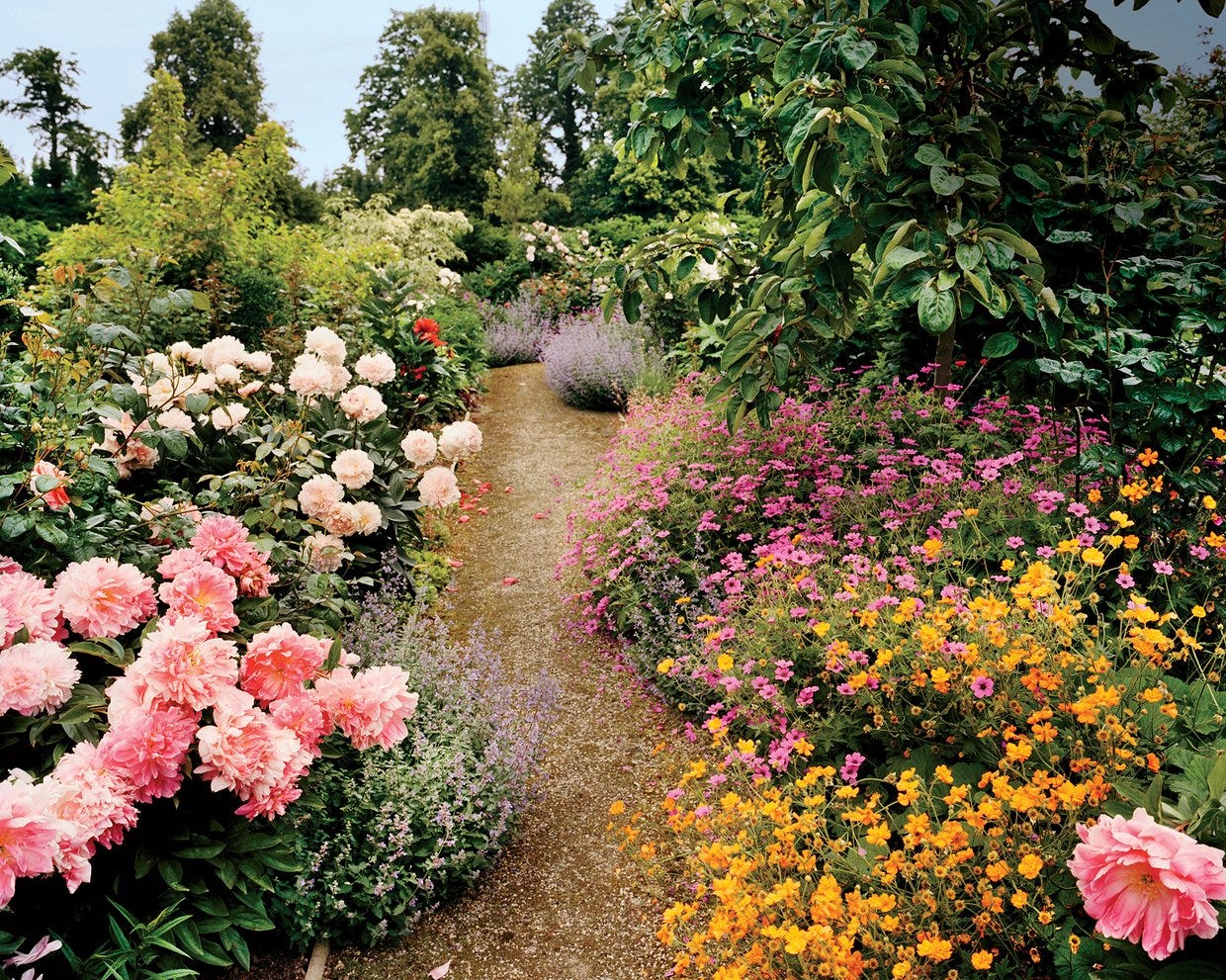
Outside of Antwerp, the garden surrounding Dries van Noten’s house is a botanical source of inspiration. If you get the chance to visit a Dries van Noten store, or one of his concessions, as you breathe in the aroma rising from the fresh bouquets, remember these things.
Prints
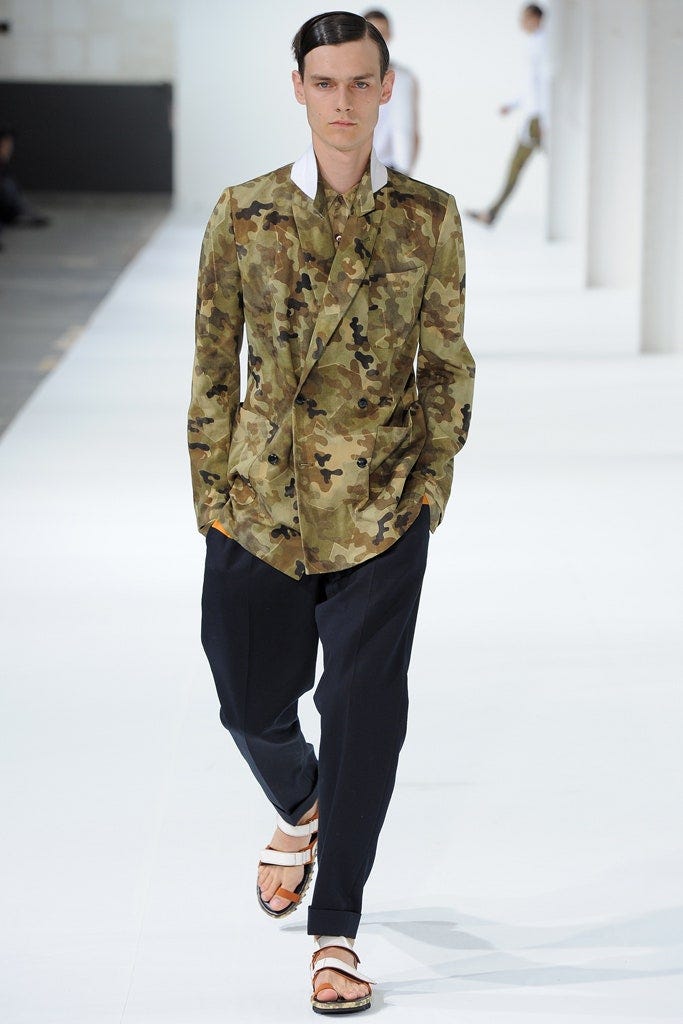
The skill of any designer goes much further than designing or selecting a suitably vibrant print.
Using a print in tailoring requires careful attention to how it is to be cut, so that its visible patterns make the most striking impact, not only when draped, but when in motion as well.
Look 4 from “Camouflage”, the Spring 2013 menswear show, is one of my favourites in this collection. Fine wool tailoring, performance nylons, and delicate silks give different interpretations of how camouflage — this most masculine and militaristic of prints — has been so closely woven into how we construct images of European masculinity.
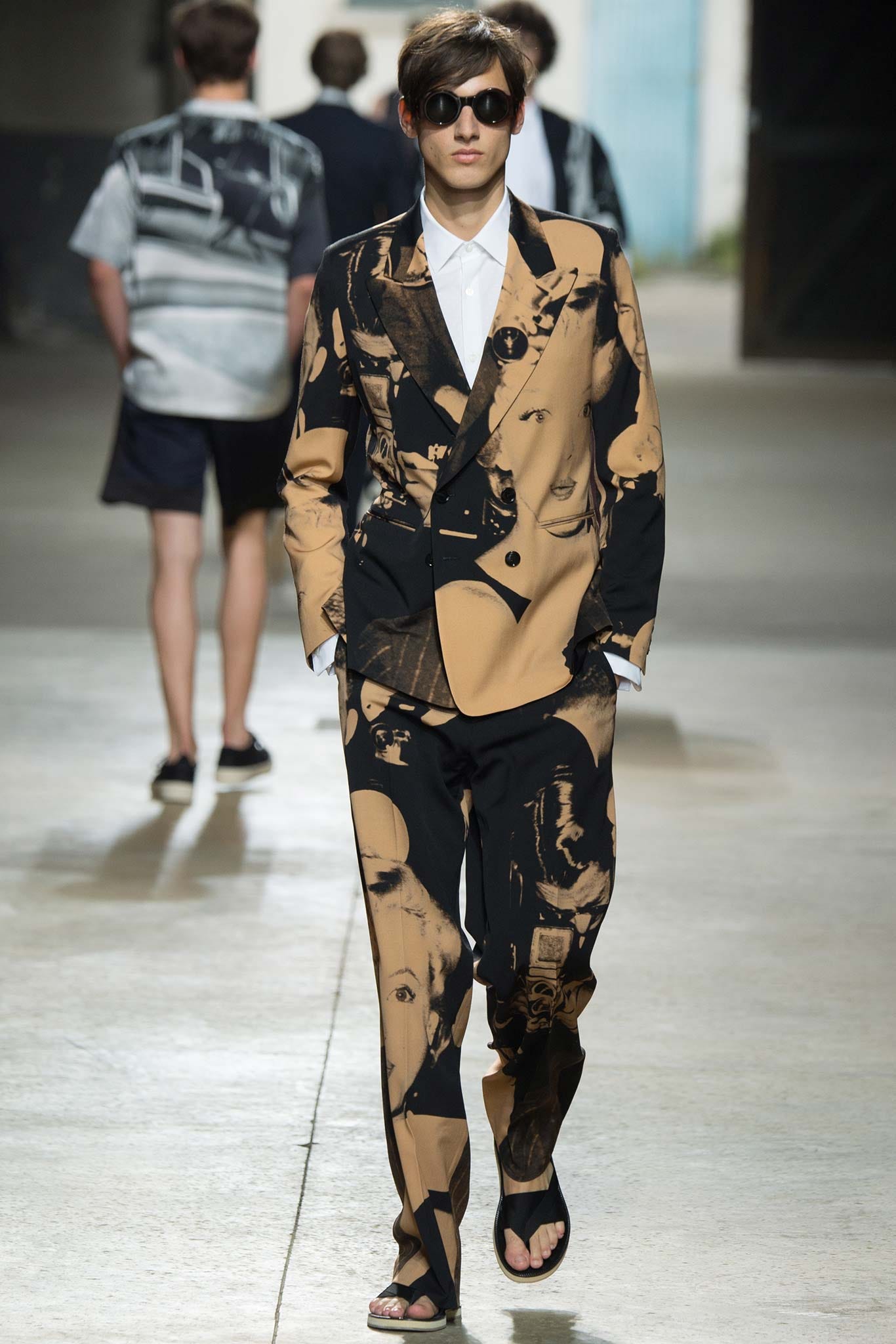
Look 51 from “Marilyn”, the Spring 2016 menswear show, uses print for a very different purpose. Far from being a way of signalling a disguise or protective layer, this celebration of one of the twentieth century’s most recognisable film stars represents the ways in which the celebrity image has become all-encompassing — it expands and consumes, rendering the wearer almost invisible.
To cut a formal suit from such a complex photographic print requires deft skill because the pattern cutter must ensure that we never lose sight of Marilyn’s gaze as the wearer walks towards us.
The next chapter
Dries van Noten announced that the Spring 2025 menswear show would be his last. This is the inevitable dilemma facing the founder of every label bearing their name — at what point do they step down, and who can they entrust to carry on their work?
The Dries van Noten label is a rare exception in a rapidly acquisitive industry. As one of the few independents, they have resisted the carousel of multiplying intermediate collections and over-abundant merchandising that has crushed the spirit of creative directors at other houses owned by larger conglomerates.
Julian Klausner, the newly appointed creative director, has taken over. He presented his first womenswear show for autumn/winter in March 2025. It is with great interest and excitement that I await the continued evolution of this label under his guidance.
Explore further
Listen
Magazine
mono.kultur, issue #20 (Out of print, so try your luck with a reseller or dig around in 0fr if you happen to be in Paris!)
Resource
The International Library of Fashion Research (ILFR) in Oslo is an archive devoted to print materials from the fashion industry. This is a good place to start if you want to access lookbooks, magazines or other memorabilia from past runway shows. They also run a lively public program of talks, symposiums, and book clubs.
Read
Dries Van Noten by Pamela Golbin (Lannoo, 2014, 308 pages). French and English editions of this book were published to coincide with the 2014 “Inspirations” retrospective on show at Les Arts Décoratifs in Paris from March to August 2014, then from October 2014 to February 2015 at ModeMuseum in Antwerp.
Unravelling Inspirations: The Non-Retrospective Of Dries Van Noten by Johanna Zanon (Fashion Research Network, 2014)
Dries Van Noten 1-100: slipcase containing beautifully high-resolution runway and behind-the-scenes photographs from Dries van Noten’s first one hundred fashion shows, split across two heavyweight volumes: 1-50, 51-100 by Dries Van Noten, Tim Blanks, and Susannah Frankel (Lannoo, 2017, 448+464 pages) — both volumes are out of print, so you will need to hunt these down from an independent, rare or specialist art bookseller
The Secret Lives of Colour by Kassia St. Clair (John Murray Press, 2018, 328 pages)
From the Archives: Inside Dries Van Noten’s Otherworldly Home and Garden in the Belgian Countryside by Hamish Bowles (Vogue, 2024)




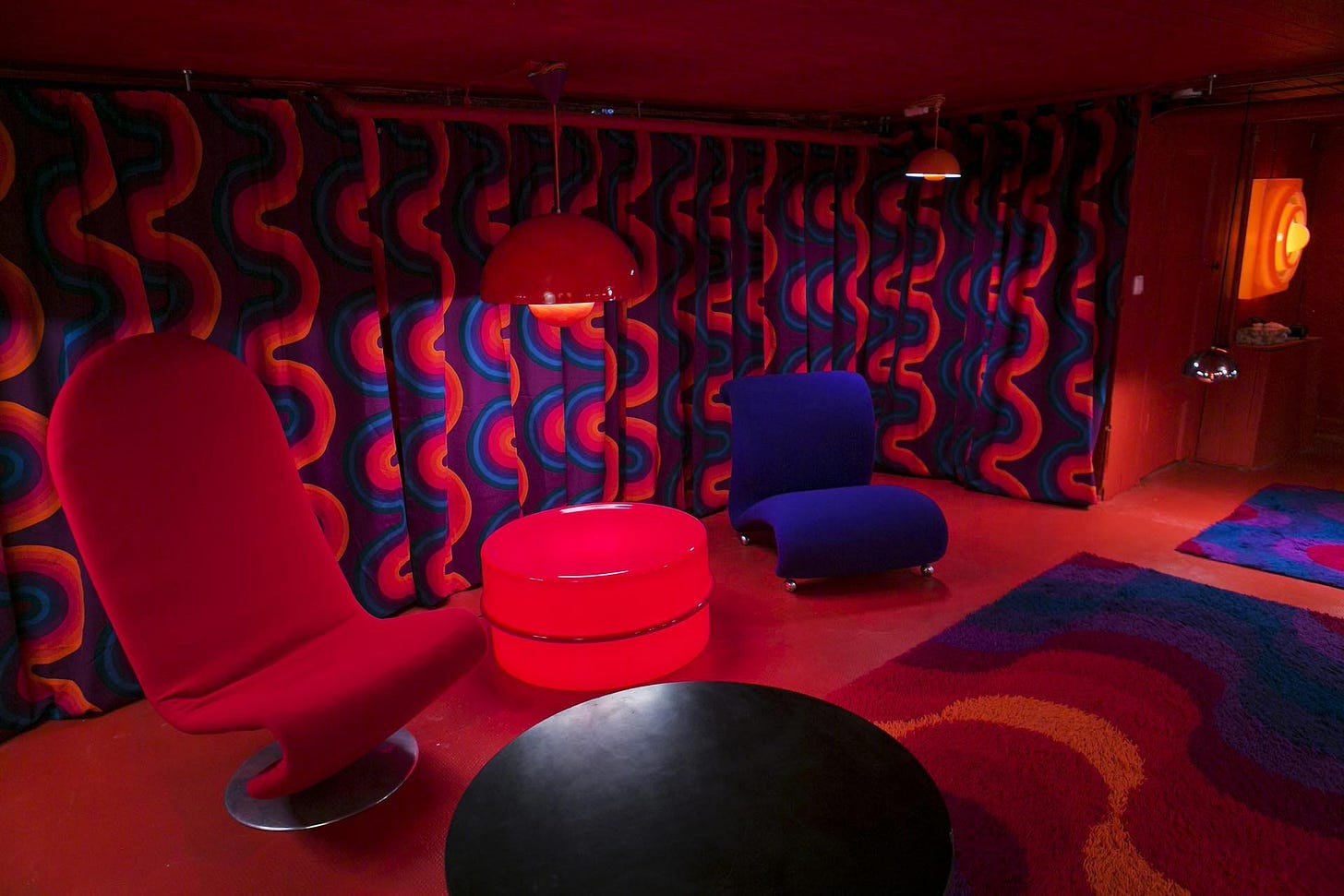
Happy April Cool’s Day and wishing you the best with your book writing 👏🏽